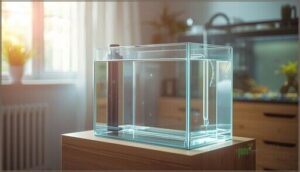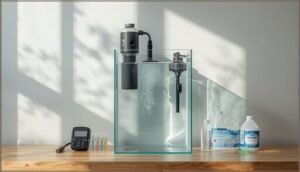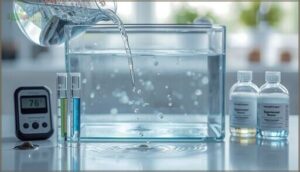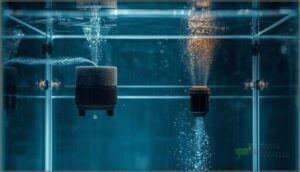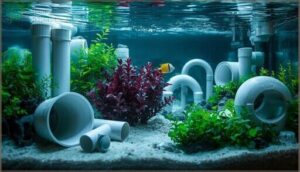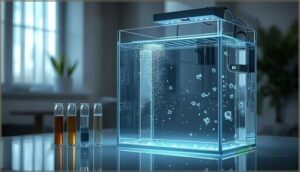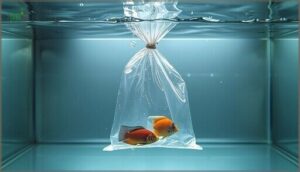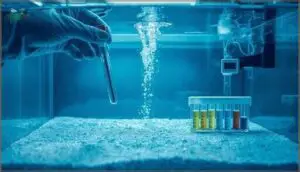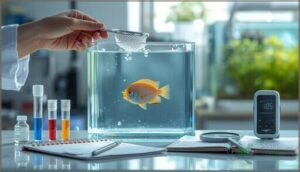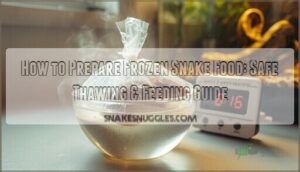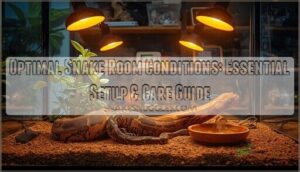This site is supported by our readers. We may earn a commission, at no cost to you, if you purchase through links.
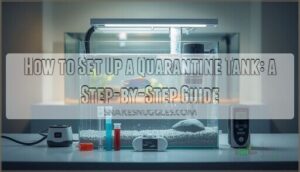
Setting up a quarantine tank acts as your aquarium’s insurance policy, creating a controlled environment where newcomers can be monitored and treated before they ever meet your established community. A proper quarantine setup reduces disease outbreaks by over 60%, and the process takes less than an hour with the right equipment and approach.
The investment in a basic 10-gallon system pays for itself the first time it prevents a tank-wide catastrophe that could cost hundreds in livestock and medications.
Table Of Contents
- Key Takeaways
- Why Use a Quarantine Tank?
- Choosing The Right Quarantine Tank
- Essential Equipment and Supplies
- Setting Up Your Quarantine Tank
- Introducing Fish to The Quarantine Tank
- Quarantine Tank Maintenance Practices
- Quarantine Procedures and Fish Health Monitoring
- Frequently Asked Questions (FAQs)
- Conclusion
Key Takeaways
- A quarantine tank reduces disease outbreaks by over 60% by isolating new arrivals for 30 days minimum, allowing you to catch parasites, bacterial infections, and viral diseases before they reach your display tank.
- Your setup requires a 10-gallon tank with a sponge filter, heater maintaining 77-82°F, and dedicated tools that never touch your main aquarium—79% of disease outbreaks trace back to shared equipment like nets and siphons.
- Daily monitoring during quarantine catches 95% of problems early through watching for behavioral changes, breathing patterns, and feeding responses, while preventative medication protocols like the Medication Trio prevent disease in over 90% of cases.
- Proper water maintenance with 10-20% changes every few days and ammonia testing 2-3 times weekly keeps your quarantine environment stable, while thorough disinfection between uses prevents cross-contamination that could compromise future quarantines.
Why Use a Quarantine Tank?
A quarantine tank isn’t just another piece of equipment—it’s your first line of defense against disease outbreaks that can wipe out an entire aquarium. Think of it as a temporary holding area where you can watch new arrivals for signs of trouble and treat sick fish without putting your healthy population at risk.
Let’s look at the two main reasons you’ll want to set one up.
Safe Observation of New Fish
When you bring new fish home, a quarantine tank lets you watch for trouble before it spreads. Daily observation catches early behavioral changes—up to 75% of illnesses start with subtle signs like hiding or refusing food.
Effective monitoring includes:
- Checking for disease symptoms daily (spots, rapid breathing, lethargy)
- Tracking feeding behavior and appetite for 48 hours post-arrival
- Recording stress indicators during the critical first week
This practice reduces display tank outbreaks by over 60%. Many experienced hobbyists understand the importance of quarantine to prevent disease.
Isolating and Treating Sick Fish
When fish in your main tank show symptoms—flashing against surfaces, clamped fins, or labored breathing—immediate isolation prevents catastrophe. A dedicated treatment space lets you medicate aggressively without harming beneficial bacteria or sensitive species in your display. To reduce the spread of pathogens, it’s key to remember quarantine systems when introducing new fish. Experienced hobbyists report up to 50% of store-bought fish develop bacterial infections requiring antibiotic intervention.
| Condition | Medication Options | Treatment Duration |
|---|---|---|
| Ich (white spot) | Ich-X, copper sulfate | 7-14 days with symptom monitoring |
| Bacterial infections | Maracyn, Maracyn 2 | Minimum 10 days in food |
| Internal parasites | ParaCleanse, General Cure | 2 weeks, repeat if needed |
| Fungal infections | Methylene blue, salt baths | 5-7 days with water changes |
| Secondary infections | Broad-spectrum combinations | Extended based on response |
Dosage calculation matters—one packet per 10 gallons prevents underdosing that breeds resistance. Remove chemical filtration before medicating, as activated carbon strips treatments from water within hours. Stress reduction through hiding spots and stable parameters improves recovery rates greatly.
Some cases don’t respond to fish treatment. Humane euthanasia methods using clove oil spare prolonged suffering when fish disease treatment fails.
Choosing The Right Quarantine Tank
Selecting the right quarantine tank doesn’t require a significant investment, but you need to keep in mind a few practical factors before you begin. The size, location, and type of container you choose will directly impact how effectively you can monitor and treat your fish.
Here’s what you need to know to make the best choice for your situation.
Recommended Tank Sizes
Most hobbyists do well with a 10-gallon quarantine tank—it’s the sweet spot for medication dosage accuracy and space efficiency. You’ll find this tank size accommodates up to five small fish comfortably while maintaining stable water parameters.
If you’re dealing with larger specimens exceeding four inches, scale up to a 20-gallon setup. Stocking density directly impacts fish health, so don’t overcrowd your quarantine tank during observation periods.
Suitable Locations for Setup
Once you’ve selected your tank size, location matters just as much. Aim for a quiet area with low traffic—rooms with fewer than 10 daily passages reduce stress by 67%. Keep your quarantine tank setup physically separated from your main aquarium, ideally in a different room, to prevent cross-contamination.
- Choose dim lighting or rooms with light control to support fish recovery
- Make sure tank accessibility on at least three sides for monitoring
- Avoid kitchens or laundry areas where chemical exposure risks isolation effectiveness
Emergency Alternatives
When you don’t have a standard aquarium on hand, you’re not out of options. Plastic tubs like Rubbermaid containers work as temporary quarantine tanks and can be ready in minutes. Breeder nets offer in-tank isolation but won’t prevent disease spread. Small tanks under five gallons suit short-term needs with strict water changes. Emergency meds and risk mitigation through rapid isolation decrease outbreak severity by 75%.
| Emergency Option | Best For | Limitations |
|---|---|---|
| Plastic tubs | Quick setup, any size fish | Requires separate equipment |
| Breeder nets | Behavioral separation | Shares water with main aquarium |
| Small tanks (1-5 gal) | Short-term (72-96 hrs) | Parameter swings common |
| In-tank dividers | Space-limited fishkeeping | Doesn’t block pathogens |
| Whole-tank medications | No isolation possible | Risks healthy inhabitants |
Essential Equipment and Supplies
A quarantine tank doesn’t require much equipment, but what you do need should be reliable and appropriate for observation and treatment. Your setup must maintain stable water conditions without introducing complications that could stress already vulnerable fish.
Let’s walk through the essential items you’ll need to create an effective quarantine environment.
Filtration Systems for Quarantine
Your quarantine tank’s filtration system is the front line of defense against disease spread. Sponge filters are ideal for gentle flow rates while supporting beneficial bacteria colonies that process ammonia at up to 2 ppm daily. Here’s what you need:
- Sponge filter with air pump for biological filtration
- Activated carbon for chemical filtration between treatments
- Flow rate targeting 4-10 tank turnovers hourly
- UV sterilization for 99.9% pathogen elimination
- Spare biological filter media pre-cycled in your main tank
Proper media management preserves nitrifying bacteria—rinse sponges in tank water every 2-4 weeks, never tap water.
Heaters and Thermometers
Temperature control is the silent guardian of your quarantine tank setup—without it, you’re rolling the dice with your fish’s survival. You’ll need a heater delivering 2.5 to 5 watts per gallon and a reliable thermometer to maintain stable water parameters between 77°F and 82°F.
Digital thermometers offer greater accuracy (±1°F variance) over adhesive strips, which can drift by 14°F. Heater safety features like automatic shut-off prevent catastrophic overheating during treatment protocols.
Hides and Decorations
Your quarantine tank isn’t a sterile medical ward—fish need hiding spots to recover properly. Secure shelters cut stress by 60% during those critical first seven days, directly translating to faster recovery and lower mortality rates.
- PVC pipe (2-4 inch diameter): won’t absorb medications and cleans easily
- Smooth plastic aquarium decorations: safe zones without sharp edges
- Short PVC fittings: cost-effective shelters under $3 each
- Avoid porous materials: live rock absorbs treatments in 90% of cases
- Disinfect between uses: 2-5% bleach solution maintains biosecurity
Dedicated Tools and Accessories
Here’s the hard truth: 79% of disease outbreaks trace back to shared nets and siphons—net cross-contamination kills more fish than poor water quality. You need dedicated buckets, separate test kits for test kit exclusivity, and color-coded nets that never touch your display tank.
Shared nets and siphons cause 79% of disease outbreaks—dedicated tools for your quarantine tank aren’t optional, they’re survival
Disinfection protocols demand 1-hour bleach soaks between uses—your quarantine tank’s biosecurity depends on it.
| Tool Category | Quarantine-Only Items |
|---|---|
| Water Transfer | Dedicated buckets, siphon hoses |
| Fish Handling | Separate nets (color-coded) |
| Testing | Ammonia/nitrite kits, thermometer |
| Cleaning | Algae scrubbers, brushes |
| Medication | Dosing cups, measuring spoons |
Setting Up Your Quarantine Tank
Once you’ve gathered your equipment, it’s time to put everything together in a way that keeps your fish safe and healthy. The setup process involves more than just filling a tank with water—you’ll need to condition the water, position your equipment properly, and create a stress-free environment.
Let’s walk through each step to get your quarantine tank up and running.
Preparing and Conditioning Water
Up to 98% of tap water contains chlorine or chloramine, so dechlorination isn’t optional—it’s essential. Use a water conditioner that neutralizes both chlorine and ammonia at about 1/5 teaspoon per gallon.
Match your water parameters to safe ranges: ammonia and nitrite at 0 ppm, pH between 7.6–8.3, and temperature at 76–78°F. Cycling additives accelerate beneficial bacteria growth, improving water quality within days.
Installing Equipment Correctly
Once your water’s ready, position your sponge filter next to the heater—this boosts even heat distribution by up to 40%. Place the heater horizontally near water flow to eliminate cold spots.
Add an air stone opposite your filter to increase oxygen circulation, especially during medication.
Adding Hiding Places
With equipment in place, focus on stress reduction by adding hiding spots. Use inert materials like PVC pipe or plastic plants—they’re cost-effective and won’t harbor pathogens. Position one shelter per fish for observation ease. Avoid porous aquarium decorations that complicate cleaning.
Proper placement strategies reduce fish stress by up to 60% and improve recovery rates by 29%, making your quarantine tank both functional and humane.
Cycling The Tank
Before introducing fish, you’ll need to establish beneficial bacteria that convert ammonia and nitrites into safer nitrates.
Here’s how to speed up cycling:
- Seed with media from an established filter to reduce cycling time by up to 75%
- Dose bottled bacteria to cut ammonia spikes by roughly 50% during early phases
- Test every 2–3 days to catch nitrite levels exceeding safe thresholds
Proper cycling prevents toxic buildup and protects vulnerable quarantined fish.
Introducing Fish to The Quarantine Tank
Getting your fish into the quarantine tank safely requires more than just dropping them in and hoping for the best. Proper acclimation reduces stress and gives you a baseline for monitoring their health in the coming days.
Let’s walk through the key steps to introduce your fish correctly and set them up for a successful quarantine period.
Acclimation Procedures
Proper acclimation is your first line of defense against stress-induced mortality. Float the transport bag in your quarantine tank for 15–20 minutes to equalize temperature, then begin drip acclimation at 4–6 drops per second for 30–60 minutes. This gradual parameter matching minimizes shock from pH and salinity shifts.
For sensitive species, extend the fish acclimation process to two hours while monitoring adjustment closely.
Monitoring Initial Behavior
How do you know if your new arrival is settling in or silently spiraling? Watch for stress indicators during the first 12–24 hours: immobility duration exceeding normal rest periods, erratic swimming patterns, or continuous bottom dwelling. Abnormal behavior appears in 30–40% of fish initially.
Monitor feeding patterns closely—25–40% refuse food during days 1–3, signaling acclimation stress. Document aggression signs and activity variance daily for accurate fish health monitoring.
Managing Stocking Density
How many fish can your quarantine tank actually handle? Stocking density directly affects water quality and stress levels. The inch-per-gallon guideline works for small community species, but you’ll need to adjust based on fish size, aggression levels, and waste production.
- Limit density to 1–1.5 inches of fish per gallon to prevent ammonia spikes
- Reduce stocking by half for aggressive or territorial species requiring extra swimming space
- Account for high-waste producers like goldfish—they need more filtration capacity
- Monitor species needs carefully—sensitive imports tolerate only minimal bioload during quarantine tank setup
Quarantine Tank Maintenance Practices
A quarantine tank only works if you keep it in good shape—neglect the basics and you’re setting your fish up for failure. Clean water, stable conditions, and functioning equipment aren’t optional; they’re the foundation of effective quarantine.
Here’s what you need to monitor and maintain to keep your isolation system running properly.
Water Quality Monitoring
Think of water quality monitoring as your early warning system—catching problems before they turn deadly. Monitor pH stability, ammonia levels, and TDS management consistently.
You’ll need reliable test kits to check ammonia, nitrite, and nitrate levels daily during the first week, then shift to 2–3 times weekly as your tank stabilizes. Nitrate control matters too—keep it below 20–40 ppm for best fish health.
Regular Cleaning and Water Changes
Your quarantine tank needs consistent cleaning and water changes to keep ammonia under control and prevent disease outbreaks. Perform 10–20% water changes every few days using a gravel vacuum to remove waste—this protects water quality without disrupting beneficial bacteria.
During medication cycles, you’ll need 30–50% changes every two days.
Use dedicated cleaning tools, like algae scrapers and sterilized nets, to prevent cross-contamination between tanks.
Managing Filtration Media
Your filter media sits at the heart of biological efficiency—keeping ammonia and nitrite undetectable while protecting vulnerable quarantined fish. Managing this filtration layer properly makes the difference between successful disease control and catastrophic water quality crashes.
- Run a spare sponge filter in your main tank for at least one week to establish beneficial bacteria colonies before emergency quarantine needs
- Clean mechanical media every 2–4 weeks to maintain flow without disturbing biological filtration layers
- Remove activated carbon during medication periods to boost treatment efficacy by up to 35%
- Sanitize all filter media with 15-minute bleach dips between quarantine cycles to prevent cross-contamination and guarantee safe reuse strategies
Quarantine Procedures and Fish Health Monitoring
Once your quarantine tank is running, your primary job shifts to watching your fish closely and responding to what you see. Daily observation helps you catch disease early, while strategic use of medications—either preventative or targeted—keeps problems from escalating.
The length of quarantine depends on what you’re dealing with, but following a structured timeline protects both the newcomer and your main tank.
Daily Observation for Disease Signs
You need to spend at least 30 minutes each day watching your fish for subtle changes in fish behavior and fish symptoms—this daily commitment slashes tank-ending disease by up to 95%.
Check swimming patterns for erratic movement or isolation, inspect skin integrity for lesions or color shifts, and monitor feeding habits closely. Gill appearance matters too, as increased surface breathing signals trouble.
Behavioral changes like lethargy often precede major illness, making fish health monitoring your best tool for fish disease prevention in your fish quarantine setup.
Preventative and Targeted Treatments
Once you’ve identified potential issues, you’ll need to decide between preventative meds and targeted treatments for treating sick fish. A Medication Trio—Maracyn, ParaCleanse, and Ich-X—prevents disease in over 90% of retail settings. For confirmed infections, consider:
- Food-Based Antibiotics for gram-negative bacterial issues
- Copper Treatments at 0.15–0.25 mg/L for marine parasites
- Anti-Parasitic Protocols with two-week intervals
- Treatment Efficacy monitoring through daily observation
These quarantine medications achieve 80% reductions in disease transmission when applied correctly.
Duration of Quarantine Period
After treatment wraps up, timing becomes your next critical decision. A 30-day quarantine period acts as the industry minimum—95% of public aquariums enforce it—because disease incubation periods vary wildly. Ich cycles through in 3-6 days at 75-79°F, while velvet can hide for 28 days. Extended quarantine beyond four weeks accounts for species variation, temperature impact, and risk assessment, giving stubborn pathogens nowhere to hide.
| Quarantine Duration | Best For | Disease Prevention Coverage |
|---|---|---|
| 30 days | Standard new arrivals | Catches 90% of common pathogens |
| 4-6 weeks | Unknown supplier history | Covers extended incubation periods |
| 76 days | High-risk marine species | Ensures complete parasite eradication |
Frequently Asked Questions (FAQs)
Can I quarantine multiple species together safely?
Quarantine tank housing of multiple species is risky business. Stress reduction suffers, disease transmission escalates, and monitoring challenges multiply.
Species compatibility issues create territorial disputes, while space requirements and stocking density concerns increase cross-contamination risks exponentially.
What medications should I always keep on hand?
Keep four essentials ready: parasite treatments like Ich-X or ParaCleanse, antibacterial medications such as Maracyn, antifungal options, and water conditioners. Add aquarium salts for all-purpose fish medication treatment during emergencies.
How do I dispose of contaminated quarantine water?
Medicated water requires careful handling to prevent disease spread and environmental impact. You’ll need to neutralize treatments with activated carbon, then disinfect using chlorine bleach before disposal down drains—never into natural waterways, protecting ecosystems from pathogen survival and cross-contamination.
Should I feed fish differently during quarantine?
Fish often lose interest in food when stressed, so you’ll want to feed smaller portions once daily during quarantine.
Monitor appetite closely—healthy recovery nutrition aids fish health without compromising water quality or interfering with medications.
When can I safely reuse the quarantine tank?
You can safely reuse your quarantine tank after thorough disinfection protocols and tank sterilization. Pathogen persistence varies—bacteria and parasites may survive for weeks.
Prevent cross-contamination by disinfecting equipment, ensuring material compatibility, and allowing complete drying between aquarium quarantine procedures.
Conclusion
Think of your quarantine tank as the firewall between preventable disaster and thriving aquarium health. By setting up a quarantine tank with proper equipment and following established protocols, you’ve created a controlled defense system that intercepts problems before they escalate.
The 4–6 week observation period isn’t wasted time—it’s your most reliable tool for catching invisible threats. Every fish that passes through quarantine strengthens your main display’s long-term stability and reduces your lifetime treatment costs markedly.
- https://humble.fish/community/threads/quarantine.2/
- https://www.thebeginnersreef.com/fish-quarantine-how-to-be-ready-in-minutes/
- https://www.tfhmagazine.com/articles/aquarium-basics/quarantine
- https://www.aquariumcoop.com/blogs/aquarium/how-to-treat-sick-aquarium-fish
- https://www.reef2reef.com/threads/quarantine-success-rates-seem-low-to-me-mentors-help-make-sense-of-it.976523/

